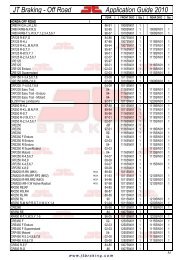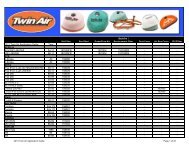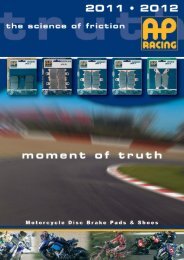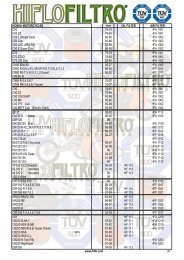DID 60 standard roller chain - Big Bike Webshop
DID 60 standard roller chain - Big Bike Webshop
DID 60 standard roller chain - Big Bike Webshop
Create successful ePaper yourself
Turn your PDF publications into a flip-book with our unique Google optimized e-Paper software.
Roller Chains for Power Transmission Maintenance<br />
Roller Chains for<br />
Power Transmission<br />
Maintenance<br />
Fracture patterns of respective <strong>chain</strong><br />
components<br />
To be aware aforetime of how and which part of the <strong>chain</strong><br />
is damaged under improper use greatly helps to clarify the<br />
cause and determine corrective measures in such an<br />
event.<br />
¡Fracture of plate.<br />
When a large tension<br />
acts to fracture a plate,<br />
as shown in (a), the cut<br />
ends are oblique and<br />
plastic deformation<br />
occurs. However, when<br />
the load is slightly larger<br />
than the maximum<br />
allowable tension, fatigue<br />
fracture occurs, and any<br />
plastic deformation does<br />
not occur as shown in<br />
(b). A significant feature of fatigue fracture is that a crack<br />
occurs in the direction almost perpendicular to the pitch line<br />
(center line between both pins). In the case of hydrogen<br />
embrittlement by an acid, the crack mostly occurs in the<br />
direction as shown in (c), and the cut ends are flat, while the<br />
area around the cut ends may be decolored due to erosion<br />
by the acid.<br />
¡Fracture of pins<br />
When a pin is fractured by<br />
excessive tension, the<br />
(d)<br />
fracture occurs close to the<br />
plate, with a bulged specular<br />
surface formed by shearing,<br />
as shown in (d). However,<br />
when the acting force is not<br />
(e)<br />
so strong, fatigue fracture<br />
takes place after a long<br />
period of time around the<br />
center of the pin as shown in (e), and the fractured surface<br />
is flat with small undulations.<br />
¡Fracture of bushings<br />
As with <strong>roller</strong>s, bushings fracture by<br />
shock. Generally, as shown in the<br />
photo, a vertical crack occurs and<br />
stops near the plates. One crack<br />
can also be superimposed on<br />
another, causing the central portion<br />
to come off. In general, it can be<br />
said that a larger crack is caused by<br />
a larger tension.<br />
(a)<br />
(b)<br />
(c)<br />
¡Fracture of <strong>roller</strong>s<br />
When a <strong>roller</strong> fractures during operation, typically vertical<br />
splitting occurs as shown in the photo, and in general,<br />
pitch marks of fatigue extend from the inside of the <strong>roller</strong><br />
and cause splitting. If splitting occurs all at once due to a<br />
large tension, the cause can be identified easily since the<br />
split faces are not polished. If tension is excessive, the<br />
<strong>roller</strong>s are forcefully pressed against the tooth faces of<br />
sprockets, and a <strong>roller</strong> end may be cracked and<br />
deformed.<br />
¡Rotation of pins<br />
As shown in the photo, the rotation<br />
of a pin can be identified by the<br />
deviance of the rivet mark on the pin<br />
head from the correct position. If the<br />
<strong>chain</strong> is disassembled, galling is<br />
found between pins and bushings in<br />
most cases. The cause of galling is<br />
improper lubrication or excessive<br />
tension. When a machine has been<br />
out of use for a long period of time, rust may develop<br />
between pins and bushings, causing the pin to rotate.<br />
Elongation of <strong>chain</strong><br />
In general, the elongation of <strong>chain</strong>s includes the<br />
following three types;<br />
1. Elastic elongation by <strong>chain</strong> tension<br />
If a load acts on a <strong>chain</strong>, the respective components of<br />
the <strong>chain</strong> are elastically deformed, causing elongation. If<br />
the load is removed, the original length is restored.<br />
2. Plastic elongation by <strong>chain</strong> tension<br />
If a load in excess of the elastic limit acts on a <strong>chain</strong>,<br />
plastic elongation occurs. In this case, even if the load is<br />
removed, the original length cannot be restored. Plastic<br />
elongation of <strong>chain</strong> may diminish its performance.<br />
Replace it without delay.<br />
3. Wear elongation of <strong>chain</strong><br />
Chains are subject to wear since pins and bushings are<br />
worn by mutual contact. After use for a long time, the<br />
wear appears as an increase of <strong>chain</strong> length. This is wear<br />
elongation. Wear elongation is an important factor for<br />
deciding the timing of <strong>chain</strong> replacement. See P.137.<br />
136









